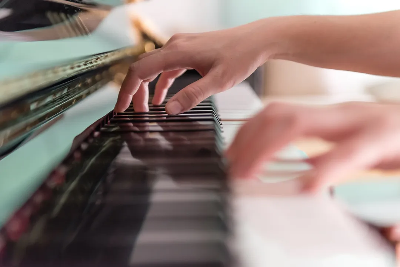Learning to play the piano well involves more than just hitting the right notes it’s about how you play them. Good piano technique is crucial because it helps you play more easily and makes your music sound better. This includes everything from how you sit at the piano to how you move your fingers across the keys. By focusing on these fundamental principles, you can improve your playing, prevent injuries, and enjoy making music even more. Whether you’re just starting out or looking to refine your skills, understanding and applying proper technique is key to becoming a better pianist.
Hand Position and Posture
Good hand position and posture are foundational to effective piano playing. Proper posture in acquiring how to play piano involves:
- sitting at the middle of the piano bench
- keeping your back straight
- having your feet flat on the floor or on a footstool if you’re shorter
- your elbows should be slightly above the keys with your forearms parallel to the floor.
As for hand position:
- fingers should be naturally curved
- wrists should be relaxed but stable, allowing for fluid movement across the keyboard
Practicing scales and arpeggios can help reinforce these positions. Beginners should regularly check their posture and hand position, even using a mirror during practice to ensure they maintain correct form.
Correcting hand position and posture after years of playing incorrectly requires patience and conscious effort. Start by re-learning the basics. It might also be helpful to work with a teacher who can provide immediate feedback and guide you in making the necessary adjustments. Remember, making these changes will take time, but the improvement in your playing and the reduction in strain will be well worth the effort.
Finger Independence and Control
Developing finger independence allows each finger to move freely and with precision, a crucial skill for playing complex piano pieces. To improve this, start with exercises designed to strengthen less dominant fingers, like the 4th and 5th.
Simple exercises such as pressing each finger against the keys with deliberate and independent motion can build strength and control.
Hanon exercises, known for enhancing dexterity and independence, are particularly beneficial. It’s important to start these exercises slowly, focusing on accuracy and evenness before increasing speed.
Weight Distribution and Touch
Effective weight distribution and touch control how the piano sounds—whether notes are played loudly, softly, or somewhere in between. This involves using the weight of your arm to produce sound rather than just pressing with your fingers, allowing for a more relaxed playing style that prevents fatigue.
Beginners should practice transferring weight smoothly from one finger to another across different dynamics. Playing with varied articulations (like staccato and legato) across scales can help develop a sensitive touch. Regularly switching between soft and loud playing in practice sessions will also train you to control volume and timbre effectively, making your performances more expressive.
Relaxation and Tension Management
Managing relaxation and tension is crucial for efficient and injury-free piano playing. Excessive tension can lead to fatigue, pain, and even long-term injuries, while proper relaxation enhances fluidity and ease of movement. To practice tension management follow these steps:
- focus on staying relaxed while playing scales or simple pieces
- notice any areas of tightness—often in the shoulders, neck, or hands
- relax these areas
Breathing exercises can also help:
- take deep breaths and exhale slowly to release tension
- regular breaks during practice sessions are important too, as they allow muscles to rest and prevent strain.
Articulation and Phrasing
Articulation and phrasing shape the expression and emotional impact of music. Articulation refers to how notes are connected or separated, such as playing smoothly (legato) or sharply (staccato).
Phrasing involves shaping a series of notes to flow like a musical sentence, bringing out the melody’s nuances. To practice, choose a piece and first speak the rhythm and melody, emphasizing natural rises and falls like in speech.
Then, play the piece, focusing on applying these expressions. Experimenting with different articulations and dynamics can also help discover the most compelling way to convey a piece’s emotional content.
Pedal Technique
The use of the pedal, particularly the sustain pedal, adds depth and resonance to piano music. The basic rule for pedal technique is to press the pedal after you play a note for a smooth, connected sound, and release it as you change chords to avoid blurring the notes together.
Beginners should start with simple pedaling exercises, such as pressing and releasing the pedal at each chord change in a slow, easy piece. Paying close attention to the sound helps develop an ear for when to change the pedal cleanly.
Over time, practicing pedaling in various musical contexts will refine your ability to use the pedal intuitively, enhancing the overall sound of your performances.
Final thoughts
In conclusion, mastering piano technique involves more than just learning where to place your fingers on the keys. It requires an understanding and implementation of several foundational aspects including proper hand position and posture, finger independence, and effective weight distribution.
Additionally, managing relaxation and tension, mastering articulation and phrasing, and skillfully using the pedal are all crucial for playing beautifully and maintaining healthy playing habits.
Regularly practicing these techniques with mindful attention to detail will not only prevent physical strain but also greatly enhance your expressiveness and overall performance.
Whether you’re a beginner or an experienced pianist, focusing on these key principles will help you play more efficiently and enjoyably, allowing your musical expressions to flourish.

